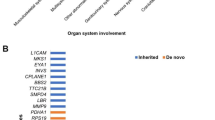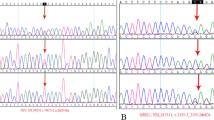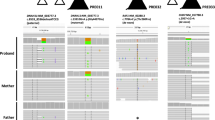Abstract
Objective
This retrospective study aimed to investigate the value of whole exome sequencing (WES) for clubfoot (CF) fetuses with or without other structural abnormalities and to further explore the genetic causes of fetal CF. Methods: this study included 83 singleton pregnancies diagnosed with fetal CF referred to our center between January 2016 and March 2022; cases were divided into two groups: isolated CF and non-isolated CF. After excluding cases with positive karyotyping and chromosomal microarray analysis results, WES was performed for the eligible fetuses and parents. Monogenic variants detected by WES and perinatal outcomes were recorded and evaluated at postnatal follow-up. Results: overall, clinically significant variations were identified in 12.0% (10/83) of fetuses, and the detection rate was significantly higher in the non-isolated than in the isolated CF group (8/36, 22.2% vs. 2/47, 4.3%, p = 0.031). We additionally detected eight (9.6%) fetuses harboring variants of unknown significance. We identified 11 clinically significant variations correlating with clinical phenotypes in nine genes from ten fetuses, with KLHL40 being the most frequent (n = 2). Furthermore, we observed a significant difference in termination and survival rates between isolated and non-isolated CF cases (27.6 vs. 77.8% and 59.6 vs. 19.4%, p < 0.001 for both). Conclusion: our data indicate that WES has a high additional diagnostic yield for the molecular diagnosis of fetal CF, markedly enhancing existing prenatal diagnostic capabilities and expanding our understanding of intrauterine genetic disorders, thus assisting us to better interpret fetal phenotype in the future.



Similar content being viewed by others
Data Availability
The data that support the findings of this study are not publicly available as the information contained could compromise the privacy of research participants. Further inquiries can be directed to the corresponding author.
References
Alazami AM, Patel N, Shamseldin HE, Anazi S, Al-Dosari MS, Alzahrani F, Hijazi H, Alshammari M, Aldahmesh MA, Salih MA, Faqeih E, Alhashem A, Bashiri FA, Al-Owain M, Kentab AY, Sogaty S, Al Tala S, Temsah MH, Tulbah M, Aljelaify RF, Alshahwan SA, Seidahmed MZ, Alhadid AA, Aldhalaan H, AlQallaf F, Kurdi W, Alfadhel M, Babay Z, Alsogheer M, Kaya N, Al-Hassnan ZN, Abdel-Salam GM, Al-Sannaa N, Al Mutairi F, El Khashab HY, Bohlega S, Jia X, Nguyen HC, Hammami R, Adly N, Mohamed JY, Abdulwahab F, Ibrahim N, Naim EA, Al-Younes B, Meyer BF, Hashem M, Shaheen R, Xiong Y, Abouelhoda M, Aldeeri AA, Monies DM, Alkuraya FS (2015) Accelerating novel candidate gene discovery in neurogenetic disorders via whole-exome sequencing of prescreened multiplex consanguineous families. Cell Rep 10:148–161
Alvarado DM, Aferol H, McCall K, Huang JB, Techy M, Buchan J, Cady J, Gonzales PR, Dobbs MB, Gurnett CA (2010) Familial isolated clubfoot is associated with recurrent chromosome 17q23.1q23.2 microduplications containing TBX4. Am J Hum Genet 87:154–160
Alvarado DM, Buchan JG, Frick SL, Herzenberg JE, Dobbs MB, Gurnett CA (2013) Copy number analysis of 413 isolated talipes equinovarus patients suggests role for transcriptional regulators of early limb development. Eur J Hum Genet 21:373–380
Alvarado DM, McCall K, Hecht JT, Dobbs MB, Gurnett CA (2016) Deletions of 5’ HOXC genes are associated with lower extremity malformations, including clubfoot and vertical talus. J Med Genet 53:250–255
Bamshad MJ, Ng SB, Bigham AW, Tabor HK, Emond MJ, Nickerson DA, Shendure J (2011) Exome sequencing as a tool for Mendelian disease gene discovery. Nat Rev Genet 12:745–755
Bar-Hava I, Bronshtein M, Orvieto R, Shalev Y, Stal S, Ben-Rafael Z (1997) Caution: prenatal clubfoot can be both a transient and a late-onset phenomenon. Prenat Diagn 17:457–460
Barker S, Chesney D, Miedzybrodzka Z, Maffulli N (2003) Genetics and epidemiology of idiopathic congenital talipes equinovarus. J Pediatr Orthop 23:265–272
Beck AE, McMillin MJ, Gildersleeve HI, Kezele PR, Shively KM, Carey JC, Regnier M, Bamshad MJ (2013) Spectrum of mutations that cause distal arthrogryposis types 1 and 2B. Am J Med Genet A 161:550–555
Biesecker LG, Green RC (2014) Diagnostic clinical genome and exome sequencing. N Engl J Med 370:2418–2425
Bronshtein M, Liberson A, Lieberson S, Blumenfeld Z (1992) Clubfeet associated with hydrocephalus: new evidence of gradual dynamic development in utero. Obstet Gynecol 79:864–867
Canto MJ, Cano S, Palau J, Ojeda F (2008) Prenatal diagnosis of clubfoot in low-risk population: associated anomalies and long-term outcome. Prenat Diagn 28:343–346
Chesney D, Barker S, Miedzybrodzka Z, Haites N, Maffulli N (1999) Epidemiology and genetic theories in the etiology of congenital talipes equinovarus. Bull Hosp Jt Dis 58:59–64
de Segno BV, Gruchy N, Bronfen C, Dolley P, Leporrier N, Creveuil C, Benoist G (2016) Prenatal diagnosis of clubfoot: Chromosomal abnormalities associated with fetal defects and outcome in a tertiary center. J Clin Ultrasound 44:100–105
Di Mascio D, Buca D, Khalil A, Rizzo G, Makatsariya A, Sileo F, Liberati M, Benedetti Panici P, Acharya G, D’Antonio F (2019) Outcome of isolated fetal talipes: A systematic review and meta-analysis. Acta Obstet Gynecol Scand 98:1367–1377
Faldini C, Fenga D, Sanzarello I, Nanni M, Traina F, Rosa MAA (2017) Prenatal Diagnosis of Clubfoot: A Review of Current Available Methodology. Folia Med (plovdiv) 59:247–253
Foster JW, Dominguez-Steglich MA, Guioli S, Kwok C, Weller PA, Stevanović M, Weissenbach J, Mansour S, Young ID, Goodfellow PN et al (1994) Campomelic dysplasia and autosomal sex reversal caused by mutations in an SRY-related gene. Nature 372:525–530
Garg A, O’Rourke J, Long C, Doering J, Ravenscroft G, Bezprozvannaya S, Nelson BR, Beetz N, Li L, Chen S, Laing NG, Grange RW, Bassel-Duby R, Olson EN (2014) KLHL40 deficiency destabilizes thin filament proteins and promotes nemaline myopathy. J Clin Invest 124:3529–3539
Hecht JT, Ester A, Scott A, Wise CA, Iovannisci DM, Lammer EJ, Langlois PH, Blanton SH (2007) NAT2 variation and idiopathic talipes equinovarus. Am J Med Genet A 143:2285–2291
Heck AL, Bray MS, Scott A, Blanton SH, Hecht JT (2005) Variation in CASP10 gene is associated with idiopathic talipes equinovarus. J Pediatr Orthop 25:598–602
Hordyjewska-Kowalczyk E, Nowosad K, Jamsheer A, Tylzanowski P (2022) Genotype-phenotype correlation in clubfoot (talipes equinovarus). J Med Genet 59:209–219
Hu QX, Li XD, Xie P, Wu CC, Zheng GZ, Lin FX, Xie D, Zhang QH, Liu DZ, Wang YG, Chang B, Du SX (2017) All-trans-retinoic acid activates SDF-1/CXCR4/ROCK2 signaling pathway to inhibit chondrogenesis. Am J Transl Res 9:2296–2305
Huang R, Yang X, Zhou H, Fu F, Cheng K, Wang Y, Ma C, Li R, Jing X, Han J, Zhen L, Pan M, Li D, Liao C (2022) Prenatal Diagnosis of Talipes Equinovarus by Ultrasound and Chromosomal Microarray Analysis: A Chinese Single-Center Retrospective Study. Genes 13(9):153
Khan YN, Huma Z, Khan U, Basit S (2020) Mutation Screening of Genes Associated with Congenital Talipes Equinovarus in Pakistani Families. J Musculoskelet Surg Res 4:25–30
Lee B, Vissing H, Ramirez F, Rogers D, Rimoin D (1989) Identification of the molecular defect in a family with spondyloepiphyseal dysplasia. Science 244:978–980
Li J, Wu J, Liu Y, Li Y, Xiao Z, Jiang X, Tang Y, Xu H (2019) HOXA9 rs3801776 G>A polymorphism increases congenital talipes equinovarus risk in a Chinese population. J Gene Med 21:e3119
Liu LY, Jin CL, Cao DH, Zhao N, Lin CK, Sun KL (2007) Analysis of association between COL9A1 gene and idiopathic congenital talipes equinovarus. Yi Chuan 29:427–432
Lord J, McMullan DJ, Eberhardt RY, Rinck G, Hamilton SJ, Quinlan-Jones E, Prigmore E, Keelagher R, Best SK, Carey GK, Mellis R, Robart S, Berry IR, Chandler KE, Cilliers D, Cresswell L, Edwards SL, Gardiner C, Henderson A, Holden ST, Homfray T, Lester T, Lewis RA, Newbury-Ecob R, Prescott K, Quarrell OW, Ramsden SC, Roberts E, Tapon D, Tooley MJ, Vasudevan PC, Weber AP, Wellesley DG, Westwood P, White H, Parker M, Williams D, Jenkins L, Scott RH, Kilby MD, Chitty LS, Hurles ME, Maher ER (2019) Prenatal exome sequencing analysis in fetal structural anomalies detected by ultrasonography (PAGE): a cohort study. Lancet 393:747–757
McKinney J, Rac MWF, Gandhi M (2019) Congenital talipes equinovarus (clubfoot). Am J Obstet Gynecol 221:B10-b12
Moravej H, Karamifar H, Karamizadeh Z, Amirhakimi G, Atashi S, Nasirabadi S (2015) Bruck syndrome - a rare syndrome of bone fragility and joint contracture and novel homozygous FKBP10 mutation. Endokrynol Pol 66:170–174
Munns CF, Rauch F, Ward L, Glorieux FH (2004) Maternal and fetal outcome after long-term pamidronate treatment before conception: a report of two cases. J Bone Miner Res 19:1742–1745
Nenna R, Turchetti A, Mastrogiorgio G, Midulla F (2019) COL2A1 Gene Mutations: Mechanisms of Spondyloepiphyseal Dysplasia Congenita. Appl Clin Genet 12:235–238
Ng SB, Buckingham KJ, Lee C, Bigham AW, Tabor HK, Dent KM, Huff CD, Shannon PT, Jabs EW, Nickerson DA, Shendure J, Bamshad MJ (2010) Exome sequencing identifies the cause of a mendelian disorder. Nat Genet 42:30–35
Nishimura G, Haga N, Kitoh H, Tanaka Y, Sonoda T, Kitamura M, Shirahama S, Itoh T, Nakashima E, Ohashi H, Ikegawa S (2005) The phenotypic spectrum of COL2A1 mutations. Hum Mutat 26:36–43
Petrovski S, Aggarwal V, Giordano JL, Stosic M, Wou K, Bier L, Spiegel E, Brennan K, Stong N, Jobanputra V, Ren Z, Zhu X, Mebane C, Nahum O, Wang Q, Kamalakaran S, Malone C, Anyane-Yeboa K, Miller R, Levy B, Goldstein DB, Wapner RJ (2019) Whole-exome sequencing in the evaluation of fetal structural anomalies: a prospective cohort study. Lancet 393:758–767
Ravenscroft G, Miyatake S, Lehtokari VL, Todd EJ, Vornanen P, Yau KS, Hayashi YK, Miyake N, Tsurusaki Y, Doi H, Saitsu H, Osaka H, Yamashita S, Ohya T, Sakamoto Y, Koshimizu E, Imamura S, Yamashita M, Ogata K, Shiina M, Bryson-Richardson RJ, Vaz R, Ceyhan O, Brownstein CA, Swanson LC, Monnot S, Romero NB, Amthor H, Kresoje N, Sivadorai P, Kiraly-Borri C, Haliloglu G, Talim B, Orhan D, Kale G, Charles AK, Fabian VA, Davis MR, Lammens M, Sewry CA, Manzur A, Muntoni F, Clarke NF, North KN, Bertini E, Nevo Y, Willichowski E, Silberg IE, Topaloglu H, Beggs AH, Allcock RJ, Nishino I, Wallgren-Pettersson C, Matsumoto N, Laing NG (2013) Mutations in KLHL40 are a frequent cause of severe autosomal-recessive nemaline myopathy. Am J Hum Genet 93:6–18
Reischer T, Liebmann-Reindl S, Bettelheim D, Balendran-Braun S, Streubel B (2020) Genetic diagnosis and clinical evaluation of severe fetal akinesia syndrome. Prenat Diagn 40:1532–1539
Retief E, Parker MI, Retief AE (1985) Regional chromosome mapping of human collagen genes alpha 2(I) and alpha 1(I) (COLIA2 and COLIA1). Hum Genet 69:304–308
Riggs ER, Andersen EF, Cherry AM, Kantarci S, Kearney H, Patel A, Raca G, Ritter DI, South ST, Thorland EC, Pineda-Alvarez D, Aradhya S, Martin CL (2020) Technical standards for the interpretation and reporting of constitutional copy-number variants: a joint consensus recommendation of the American College of Medical Genetics and Genomics (ACMG) and the Clinical Genome Resource (ClinGen). Genet Med 22:245–257
Sadler B, Gurnett CA, Dobbs MB (2019) The genetics of isolated and syndromic clubfoot. J Child Orthop 13:238–244
Sharon-Weiner M, Sukenik-Halevy R, Tepper R, Fishman A, Biron-Shental T, Markovitch O (2017) Diagnostic accuracy, work-up, and outcomes of pregnancies with clubfoot detected by prenatal sonography. Prenat Diagn 37:754–763
Sharp L, Miedzybrodzka Z, Cardy AH, Inglis J, Madrigal L, Barker S, Chesney D, Clark C, Maffulli N (2006) The C677T polymorphism in the methylenetetrahydrofolate reductase gene (MTHFR), maternal use of folic acid supplements, and risk of isolated clubfoot: A case-parent-triad analysis. Am J Epidemiol 164:852–861
Shrimpton AE, Hoo JJ (2006) A TNNI2 mutation in a family with distal arthrogryposis type 2B. Eur J Med Genet 49:201–206
Stone P, Martis W, Crawford H (2018) ’Idiopathic congenital talipes equinovarus; not always an isolated anomaly. A Review of Long-Term Outcomes’, J Matern Fetal Neonatal Med 31:2693–2698
Sung SS, Brassington AM, Grannatt K, Rutherford A, Whitby FG, Krakowiak PA, Jorde LB, Carey JC, Bamshad M (2003a) Mutations in genes encoding fast-twitch contractile proteins cause distal arthrogryposis syndromes. Am J Hum Genet 72:681–690
Sung SS, Brassington AM, Krakowiak PA, Carey JC, Jorde LB, Bamshad M (2003b) Mutations in TNNT3 cause multiple congenital contractures: a second locus for distal arthrogryposis type 2B. Am J Hum Genet 73:212–214
Vora NL, Gilmore K, Brandt A, Gustafson C, Strande N, Ramkissoon L, Hardisty E, Foreman AKM, Wilhelmsen K, Owen P, Weck KE, Berg JS, Powell CM, Powell BC (2020) An approach to integrating exome sequencing for fetal structural anomalies into clinical practice. Genet Med 22:954–961
Vorster AA, Beighton P, Ramesar RS (2016) Digitotalar dysmorphism: Molecular elucidation. S Afr Med J 106:253–255
Wang LL, Jin CL, Liu LY, Zhang X, Ji SJ, Sun KL (2005) Analysis of association between 5’ HOXD gene and idiopathic congenital talipes equinovarus. Zhonghua Yi Xue Yi Chuan Xue Za Zhi 22:653–656
Wang Z, Yan N, Liu L, Cao D, Gao M, Lin C, Jin C (2013) SOX9 overexpression plays a potential role in idiopathic congenital talipes equinovarus. Mol Med Rep 7:821–825
Wang YG, Li XD, Liu ZY, Zhang TG, Chen B, Hou GQ, Hong Q, Xie P, Du SX (2014) All-trans-retinoid acid (ATRA) may have inhibited chondrogenesis of primary hind limb bud mesenchymal cells by downregulating Pitx1 expression. Toxicol Lett 224:282–289
Weymouth KS, Blanton SH, Bamshad MJ, Beck AE, Alvarez C, Richards S, Gurnett CA, Dobbs MB, Barnes D, Mitchell LE, Hecht JT (2011) Variants in genes that encode muscle contractile proteins influence risk for isolated clubfoot. Am J Med Genet A 155:2170–2179
Yang Y, Muzny DM, Reid JG, Bainbridge MN, Willis A, Ward PA, Braxton A, Beuten J, Xia F, Niu Z, Hardison M, Person R, Bekheirnia MR, Leduc MS, Kirby A, Pham P, Scull J, Wang M, Ding Y, Plon SE, Lupski JR, Beaudet AL, Gibbs RA, Eng CM (2013) Clinical whole-exome sequencing for the diagnosis of mendelian disorders. N Engl J Med 369:1502–1511
Yang H, Zheng Z, Cai H, Li H, Ye X, Zhang X, Wang Z, Fu Q (2016) Three novel missense mutations in the filamin B gene are associated with isolated congenital talipes equinovarus. Hum Genet 135:1181–1189
Yeung KS, Yu FNY, Fung CW, Wong S, Lee HHC, Fung STH, Fung GPG, Leung KY, Chung WH, Lee YT, Ng VKS, Yu MHC, Fung JLF, Tsang MHY, Chan KYK, Chan SHS, Kan ASY, Chung BHY (2020) The KLHL40 c1516A>C is a Chinese-specific founder mutation causing nemaline myopathy 8: Report of six patients with pre- and postnatal phenotypes. Mol Genet Genomic Med 8:1229
Zankl A, Neumann L, Ignatius J, Nikkels P, Schrander-Stumpel C, Mortier G, Omran H, Wright M, Hilbert K, Bonafé L, Spranger J, Zabel B, Superti-Furga A (2005) Dominant negative mutations in the C-propeptide of COL2A1 cause platyspondylic lethal skeletal dysplasia, torrance type, and define a novel subfamily within the type 2 collagenopathies. Am J Med Genet A 133:61–67
Zhang TX, Haller G, Lin P, Alvarado DM, Hecht JT, Blanton SH, Stephens Richards B, Rice JP, Dobbs MB, Gurnett CA (2014) Genome-wide association study identifies new disease loci for isolated clubfoot. J Med Genet 51:334–339
Zhao N, Jin CL, Liu LY, Cao DH, Lin CK, Ji SJ, Sun KL (2008) Association study between mutations of transcription regulator sequences of COL1A1 gene and idiopathic con-genital talipes equinovarus. Yi Chuan 30:723–727
Zhao N, Jiang M, Han W, Bian C, Li X, Huang F, Kong Q, Li J (2011) A novel mutation in TNNT3 associated with Sheldon-Hall syndrome in a Chinese family with vertical talus. Eur J Med Genet 54:351–353
Zionts LE, Zhao G, Hitchcock K, Maewal J, Ebramzadeh E (2010) Has the rate of extensive surgery to treat idiopathic clubfoot declined in the United States? J Bone Joint Surg Am 92:882–889
Acknowledgements
We thank all the participants in this study.
Funding
This research was funded by the sub-project of the National Key R&D Program (2021YFC2701002), the National Natural Science Foundation of China (81801461, 81873836, 81771594, 81671474, 81501267), the Natural Science Foundation of Guangdong Province (2019A1515012034), the Project of Guangzhou Science and Technology Bureau (201607010341, 202201020643).
Author information
Authors and Affiliations
Contributions
Manuscript writing: RH., HZ. and CM.; Study design and manuscript editing: FF. and CL.; Document retrieval: YW., SY. and KC; Exome sequence variants classification: RL., QY. and DW.; Clinical data statistics: TL., XY. and DL. All authors have read and agreed to the published version of the manuscript.
Corresponding author
Ethics declarations
Conflict of interests
The authors declare no conflict of interest.
Ethical approval
This study was approved by the Ethics Committee of Guangzhou Women and Children’s Medical Center.
Consent to participate
Informed consent was obtained from all individual participants included in the study.
Additional information
Publisher's Note
Springer Nature remains neutral with regard to jurisdictional claims in published maps and institutional affiliations.
Supplementary Information
Below is the link to the electronic supplementary material.
Rights and permissions
Springer Nature or its licensor (e.g. a society or other partner) holds exclusive rights to this article under a publishing agreement with the author(s) or other rightsholder(s); author self-archiving of the accepted manuscript version of this article is solely governed by the terms of such publishing agreement and applicable law.
About this article
Cite this article
Huang, R., Zhou, H., Ma, C. et al. Whole exome sequencing improves genetic diagnosis of fetal clubfoot. Hum Genet 142, 407–418 (2023). https://doi.org/10.1007/s00439-022-02516-y
Received:
Accepted:
Published:
Issue Date:
DOI: https://doi.org/10.1007/s00439-022-02516-y




